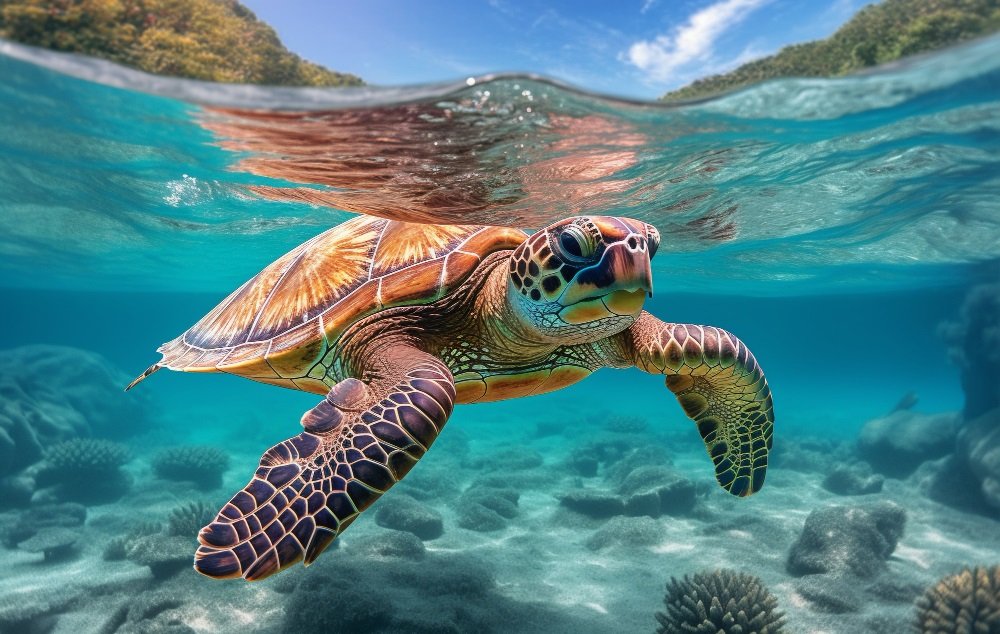Turtles are fascinating creatures that have been on our planet for over 200 million years. As semi-aquatic animals, they spend a significant amount of time in water, but they also need to come out of the water to bask, nest, and forage for food. However, many turtle owners and enthusiasts often wonder how long turtles can stay out of the water without risking their health. This is a crucial question, as turtles require a delicate balance of aquatic and terrestrial environments to thrive.
Understanding the Importance of Water and Land for Turtles
Turtles have evolved to live in both water and on land, and each environment plays a vital role in their survival. Water provides turtles with a habitat to swim, hunt, and escape from predators, while land offers a platform to bask, nest, and regulate their body temperature. A turtle’s ability to transition between these two environments is critical to its overall health and well-being.
The Risks of Prolonged Terrestrial Exposure
While turtles can survive out of water for extended periods, prolonged terrestrial exposure can lead to dehydration, overheating, and even death. Turtles that stay out of the water for too long can experience respiratory distress, skin problems, and a weakened immune system. Therefore, it is essential to understand how long turtles can safely stay out of the water and what factors influence their ability to survive in a terrestrial environment.
In this article, we will delve into the world of turtles and explore how long they can stay out of the water. We will discuss the factors that affect their ability to survive on land, provide guidance on creating a suitable environment for turtles, and offer tips for turtle owners to ensure their pets stay healthy and happy.
How Long Can Turtles Stay Out of the Water?
Turtles are semi-aquatic creatures that spend a significant amount of time in water, but they also need to come out of the water to bask, nest, and perform other essential activities. The length of time a turtle can stay out of the water depends on various factors, including the species, age, size, and environmental conditions. In this article, we will explore the different aspects of a turtle’s ability to stay out of the water and provide guidance on how to care for your pet turtle.
Factors Affecting a Turtle’s Ability to Stay Out of the Water
Several factors influence a turtle’s ability to stay out of the water, including: (See Also: What Bacteria Do Turtles Carry)
- Species: Different turtle species have varying levels of tolerance to dry conditions. Some species, like the African spurred tortoise, can survive for months without water, while others, like the red-eared slider, need to stay in the water most of the time.
- Age: Baby turtles and juveniles are more sensitive to dehydration than adult turtles and may need to stay in the water more frequently.
- Size: Smaller turtles have a higher surface-to-volume ratio, which means they lose water more quickly and may need to stay in the water longer to rehydrate.
- Environmental Conditions: Temperature, humidity, and air quality can affect a turtle’s ability to stay out of the water. High temperatures and low humidity can cause dehydration, while poor air quality can irritate the turtle’s skin and eyes.
- Health Status: Turtles with underlying health issues, such as respiratory infections or skin problems, may need to stay in the water more frequently to recover.
How Long Can Turtles Stay Out of the Water?
The length of time a turtle can stay out of the water varies depending on the species and environmental conditions. Here are some general guidelines:
| Species | Time Out of Water |
|---|---|
| African Spurred Tortoise | Several months |
| Red-Eared Slider | Several hours to a few days |
| Box Turtle | Several days to a week |
| Leopard Turtle | Several hours to a few days |
It’s essential to note that these are general guidelines, and the specific needs of your turtle may vary. It’s always better to err on the side of caution and provide a safe and humid environment for your turtle to thrive.
Signs of Dehydration in Turtles
Dehydration can be a serious issue in turtles, and it’s essential to recognize the signs early on. Here are some common signs of dehydration in turtles:
- Dry, wrinkled skin: Dehydrated turtles may develop dry, wrinkled skin that feels rough to the touch.
- Sunken eyes: Dehydrated turtles may have sunken eyes that appear dull and lackluster.
- Lethargy: Dehydrated turtles may become lethargic and less active than usual.
- Loss of appetite: Dehydrated turtles may lose their appetite and refuse to eat.
- Dark urine: Dehydrated turtles may produce dark, concentrated urine.
How to Keep Your Turtle Safe Out of the Water
To keep your turtle safe out of the water, follow these guidelines:
- Provide a humid environment: Maintain a humid environment with a temperature range of 75-85°F (24-29°C) and a relative humidity of 50-60%.
- Use a substrate that retains moisture: Use a substrate like sphagnum moss or coconut fiber that can retain moisture and help maintain humidity.
- Provide a water bowl: Provide a shallow water bowl for your turtle to drink from and soak in.
- Monitor temperature and humidity: Monitor the temperature and humidity levels regularly to ensure they are within the recommended range.
- Provide regular misting: Mist the enclosure regularly to maintain humidity and provide your turtle with a source of water.
- Limit time out of water: Limit the time your turtle spends out of the water to prevent dehydration and stress.
Conclusion
In conclusion, the length of time a turtle can stay out of the water depends on various factors, including species, age, size, and environmental conditions. It’s essential to recognize the signs of dehydration and provide a safe and humid environment for your turtle to thrive. By following the guidelines outlined in this article, you can ensure your turtle stays healthy and happy. (See Also: What Do Turtles Symbolize In Japan)
Recap
In this article, we discussed the following key points:
- Turtles can stay out of the water for varying lengths of time depending on the species and environmental conditions.
- Factors such as age, size, and health status can affect a turtle’s ability to stay out of the water.
- Signs of dehydration in turtles include dry, wrinkled skin, sunken eyes, lethargy, loss of appetite, and dark urine.
- To keep your turtle safe out of the water, provide a humid environment, use a substrate that retains moisture, provide a water bowl, monitor temperature and humidity, provide regular misting, and limit time out of water.
By understanding these key points, you can provide the best possible care for your turtle and ensure it stays healthy and happy.
Frequently Asked Questions: How Long Can Turtles Stay Out Of The Water
How long can turtles stay out of water without getting dehydrated?
Turtles can stay out of water for several hours to a few days without getting dehydrated, depending on the species and environmental conditions. For example, some aquatic turtles can survive for up to 5 days out of water, while others may need to return to water within 24 hours. It’s essential to provide a shallow water dish for your turtle to soak in regularly to prevent dehydration.
Can turtles breathe outside of water?
Yes, turtles can breathe outside of water, but they still need access to water to thrive. Turtles have lungs, and they can take in oxygen from the air. However, they also need to keep their skin and eyes moist, which is why they need to return to water regularly. Some species, like box turtles, can stay out of water for longer periods, but they still require access to water to drink and soak.
How often should I let my turtle bask out of water?
It’s essential to provide your turtle with regular basking opportunities to help regulate their body temperature and promote calcium metabolism. The frequency of basking depends on the species, age, and size of your turtle. As a general rule, provide a basking area with a heat source and UVB lighting for 2-4 hours daily, but ensure your turtle can easily return to water if needed. (See Also: Do Turtles Eat Vegetables)
What are the signs of dehydration in turtles?
Signs of dehydration in turtles include lethargy, sunken eyes, wrinkled skin, and a dry, dull shell. If you notice any of these symptoms, provide your turtle with a shallow water dish and a humid environment to help them rehydrate. You can also offer a water-rich diet, such as leafy greens or fruits, to help replenish lost fluids.
Can I keep my turtle out of water permanently?
No, it’s not recommended to keep your turtle out of water permanently. While turtles can survive for short periods without water, they are aquatic animals that require access to water to thrive. Prolonged dehydration can lead to serious health issues, including respiratory problems, skin infections, and even death. Ensure your turtle has a suitable aquatic environment with adequate water quality, temperature, and space to swim and thrive.



